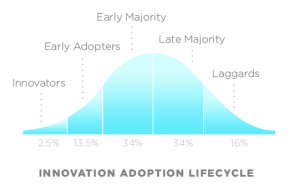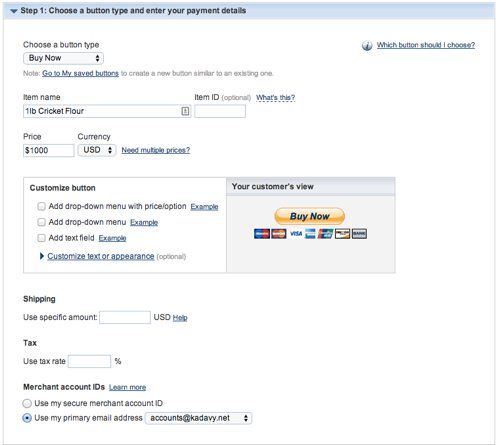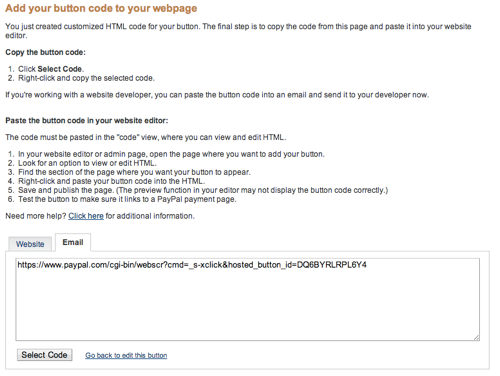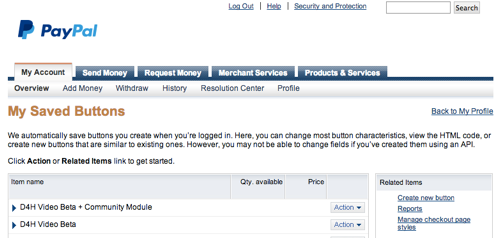Subscribe to blog updates via email »
Landing pages are for wimps: how I cured my wantrepreneuritis (& earned $5,000 in the process)
Wantrapreneuritis is a horrible disease that plagues millions of men and women, young and old, around the world. Symptoms include:
- Talking about stuff you want to do.
- Not doing that stuff because [insert excuse/scapegoat here].
- Spending countless hours looking at Analytics and running A/B tests on landing pages that don’t sell anything, and that have about 10 visitors a month. Or, worse yet, reading articles about analytics and A/B tests, but not actually having a site to run these on. (These findings just fuel the excuses for Not Doing Stuff.)
- “Pivoting” so you can repeat the cycle again.
Wantrapreneuritis causes delusions that you are making progress, when you are in fact just keeping yourself busy, basking in the reflective glory of real entrepreneurs, and protecting your fragile ego from the harshness of reality.
How do I know so much about wantreprenueritis? Because I’m a recovering wantrepreneur myself. I’ve spent 10 years fighting my own wantrepreneuritis. All of the friends I’ve known since my earliest days of wantrepreneuritis are now rich. I’m the biggest wantrepreneur I’ve ever known!

WANT TO WRITE A BOOK?
Download your FREE copy of How to Write a Book »
(for a limited time)
The last time I launched a product, I made the big wantrepreneur mistake of thinking that everything had to meet my most grand vision before I could make a dime.
Over a year (yes, a year) after actually creating the content, I spent months building a landing page, and a customer portal, and spent thousands of dollars on production and licensing. When I finally launched, I made some money, but nowhere near what I expected. I had dreams of rollin’ in an Uber black car, instead I was riding a razor scooter.
I was thrilled with the quality of my product, and so were my customers, but the revenues weren’t going to keep me in business. I had to shelve my product and move on.
WWNKD? How I cured my latest bout of wantrepreneuritis
While working on my latest product – a video course based on my book, Design for Hackers – my wantrepreneuritis flared up again.
I had been running surveys with my customers, doing little tests, and crunching numbers in a spreadsheet, trying to figure out how much money I would make off of the launch. I even spent more than $1,000 going to a conference to try to untangle all of the questions in my head. I nearly spent several thousand more on a course that would have only perpetuated my wantrepreneuritis.
The problem was, I had no idea how much money I would make, so I didn’t know if there would be enough revenue to build my product to the grandiose heights I wanted it to reach. I felt like I was steering a big ship in the middle of the ocean, with no navigation equipment, and no landmarks in sight, so I fooled myself into just drifting in the sea.
Then I remembered my mantra: WWNKD?
No, that’s not “What Would New Kids (on the Block) Do?” (The answer to that would be “hang tough” anyway, and that’s just not useful advice.)
Instead, I asked myself “What Would Noah Kagan Do?” Noah is my friend, but also the king of getting a product validated and rolling. Did you ever read about how he started AppSumo with $50?
I imagined Noah standing there, drilling me with questions, as he often does.
“How long have you been working on this?”
(Sheepishly) “8 weeks.”
“And you haven’t made any money? No idea should take more than 24 hours to get validated!”
“But I have to make the customer portal, and the landing page, and…”
(SUMO CHOP!)
Noah was right. I deserved to be sumo chopped upside the head. I had everything that I needed to earn real money, validate my product, and start delivering real value to customers. More importantly, I could do all of this before doing any more work.
I had been afraid of not having everything perfect, and I had been afraid of that uncomfortable feeling of asking for someone’s hard-earned money in exchange for the responsibility of delivering real value to solve their problem. I knew I finally had to take action.
No naysaying: a classic wantrepreneuritis symptom
Before I get into details, I want to admit I was starting with a pretty good base. I already had a best-selling book, and nearly 30,000 email subscribers, thanks to my free email course.
If you are not a best-selling author with 30,000 email subscribers, don’t go naysaying yourself on the things I’m about to tell you – a classic wantrepreneuritis symptom. You can validate a product starting with nearly nothing. If anything, having a larger following makes wantrepreneuritis even more severe – the cost of failure can seem much larger.
The fact that wantrepreneuritis can cripple even someone like me is proof of how serious a condition it is. The faster you can fight through it, the faster you can start making progress.
Earn money: no landing page required
To cure my wantrepreneuritis, I knew I had to answer the most important questions in my head (and forget about the other questions), with as little effort as possible. My thought process was like this:
- “Why am I stuck?” I don’t know how much money I’ll earn, so I don’t know how much to invest in the product, or whether I should be building it at all.
- “How can I find out how much money I’ll earn?” By selling to a sample of customers, and making a projection.
- “How can I sell to customers?” By making a product and a landing page, and…
- “WRONG! How can I sell to customers?” By making a product, and…
- “WRONG! How can I sell to customers?” By getting customers to pay me.
- “GOOD! How can you get customers to pay you?” Tell them about a product, give them a PayPal link, then make the product.
Within a couple of hours of completing this exercise, I had sent off an email to a small section of my list. Within several days, I already had nearly $2k in my PayPal account.
Best of all, I now not only had a series of deadlines I had committed to, but I had newfound confidence in my project. I could comfortably work on it, knowing my hard work would be rewarded.
I’ve run another small campaign since then, and I now have earned nearly $5,000 for a product that isn’t even finished yet. This is good because:

- Money is good. Having earned some money from the project, I can now move forward with confidence. Instead of floating in the sea, I’m full speed ahead.
- I have realistic expectations. $5,000 is either lots of money, or not-that-much money to you. There’s no limit to how amazing I’d like to make my video course. If I had it my way, it would be directed by Steven Spielberg (actually, Alexander Payne, but you’ve probably never heard of him), and a rainbow would pop out of the screen and give you a back rub at the end of each lesson. $5,000 is not enough to warrant rainbow-popping, so I’ll have to make the best product I can otherwise.
Here’s how I earned money with no landing page (nor product).
Do a beta version
If I tried to make my product perfect, it would never get done. The thing is, most people don’t care if a rainbow pops out of the screen. They just want the most valuable parts – the content.
Besides, my experience with doing such a production was nearly non-existent. I didn’t even know what kind of mic I wanted to use for sound. If I tried to make it perfect the first time around, I’d surely never get done.
By committing to – and selling – a beta version of my course to my customers, I was able to get money early on in my project, and learn about how to make it even better while I made a version of the product that was supposed to be less-than-perfect.
I’ve got nothing against making ridiculously amazing products. I actually wake up every day with the mission of blowing minds. But it’s okay if it’s a long, iterative process. Doing a beta version gives yourself permission to suck at first, which is the first step to being mind-blowing.
Sell before you work
When I earned my first $2k for the beta version of my video course, I actually didn’t have even one of the 21 video lessons produced.
Instead, I outlined a production schedule, and told my potential customers I’d deliver my course in quarters. They’d get the first quarter of the course in 3 weeks, and one-quarter of the course every two weeks after that.
Having deadlines like this – from customers that have already paid you money – is highly motivating. Imagine this compared to trudging away on a project all on your own. It would never get done!
Since the beta version gave me permission to experiment throughout the process, I used an entirely different mic setup on every section of the course, getting better as I learned.
Landing pages are for wimps
People in startupland are obsessed with landing pages. There are entire businesses built around helping you put up and test landing pages, and since there’s so much money to be made selling you landing pages, there’s an inordinate amount of information supporting the landing page craze. (I’m not saying it’s some vast conspiracy. This is just how capitalism works.)
Landing pages can be useful. They explain your product, make your customer feel comfortable with you, and answer any questions your customer might have.
But landing pages are for your wimpiest customers. They’re for the I’m-not-so-sure-maybe-if-there’s-a-discount-and-its-the-third-Wednesday-of-the-month-and-Mercury-isn’t-in-retrograde customers.
Remember this “early adopter” curve from every Lean Startup blog post ever?

Landing pages don’t serve your “Innovators”
The customers who need a landing page are somewhere in that “Early Adopter” part of the curve. They’re probably actually really cool people who would be good to have a caramel with, but they’re not who you’re looking for.
If your product is going to survive, there’d better be some “Innovator” customers. These are the I-don’t-care-if-I-have-to-pay-by-carrier-pigeon-just-make-the-pain-stop-oh-it-hurts customers.
These customers don’t care about your landing page. In fact, making a landing page does them a disservice. They could be enjoying your product, and you’re futzing around on Unbounce? SMH.
How to use a PayPal link instead of a landing page
Instead of messing around with a landing page when I could have been working on my product, I just put PayPal links directly in the email.
It sounds pretty damn simple, and it is. But if I tell you how, you’re more likely to do it, so here it goes:
1. Go to “My Saved Buttons” in PayPal
This is where your buttons will live, and you can refer back to it to edit them. I couldn’t find this through PayPal’s navigation (Update: it’s under “My Account > Profile > My Selling Tools…thanks Angelo), so here’s the link.
2. Click on “Create New Button”
3. Enter your product details
You can enter the item name, the price, and the inventory.

Pro tip: under “customize advanced features,” create a custom field for “What email is subscribed to our list?” People tend to have a different email address for PayPal than they have subscribed to your email list, so you can update their file in MailChimp or whatever you use.

Yes, you’ll have to manually update their info in MailChimp, like some sort of caveman, but we’re not trying to get hundreds of customers at this point. You’ll survive.
4. Click on “Create Button”
5. Put the link(s) in your email

Copy the URL from the “Email” tab on the “add your button code to your webpage” screen.
Then, make links in your email. (Be sure to include a note about filling in the email they’re subscribed with.)

When your (coolest) customers click on the links, they get sent directly to a PayPal page where they can sign in and pay you.

Email funnel tips for selling without a landing page
One good thing about landing pages is they create one place for all of the information on your product. Putting all of this in one email can get a bit cramped.
So, you’ve gotta break things up for a bit. Send out emails over the course of several days that generally follow the old AIDA sequence (Awareness, Interest, Desire, Action).
(Email content paraphrased)
- Email 1 – Friday: “Hey, you’re eligible for the beta of this thing I’m working on. I’ll send you details next week.”
- Email 2 – Monday: “Here are the details about what this is and why you’d want it. Here’s how to pay me.”
- Email 3 – Wednesday: “Here is an interesting story about why this product is really great.”
- Email 4 – Friday: “Today is the last day. Also, there’s a money-back guarantee, so don’t worry.” (Assuage doubts at this stage)
- Email 5 – Friday night: “Only a few more hours to get in. Don’t miss it!”
I didn’t run any tests to see if this is a good funnel, because I think split-testing is stupid at this stage (thoughts for another post). If you know your customer well and you’re not a weirdo, just think about how you’d talk to them and do it like that. If you don’t sell at all (and have 500+ people on your list), it’s probably not because you used the wrong subject line.
Get out there and serve your customers
After offering beta access to a little fewer than 12,000 of my customers, I’ve made about $5,000 on my video course. About 18,000 of them haven’t even had a chance to buy, so all-in-all, I imagine I’ll gross around $20k when I launch in July (expecting a higher sales-rate since it won’t be a “beta” anymore, and yes, there will be a landing page).
Before you’re all like, “damn, son, @kadavy be ballin’!” keep in mind I spend well over $200 a month just sending people free emails through MailChimp, I have a number of contractors to pay to help me with producing the course, and I’ve been building up to this for years. There’s still lots of wantrepreneuritis in my system.
As long as you have a product idea, and a target customer, you can start making money before you even do all of the work. Don’t let wantrepreneuritis hold you back by filling your head with grandiose ideas. Eliminate all barriers to collecting money from the customers that want your product the most, and start shipping product.
And if you ever get lost, remember: WWNKD?
Landing pages are for wimps: how I cured my wantrepreneuritis & earned $5k in the process http://t.co/PLAIJlcB9K (my latest)
— ? David Kadavy | Time ?? Mind Management (@kadavy) June 24, 2014




